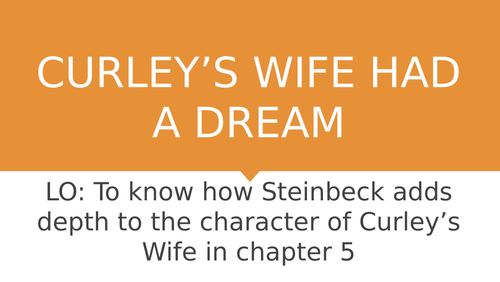





A series of three lessons on Chapter 5 of Of Mice and Men, with a focus on Curley’s Wife. These consider whether she is a victim or villain.
With chapter 5 of this novel, I think it’s important to read the chapter all in one go. As such, the first of these lessons focuses on what our previous opinions were of her, and then has a reading session. At the end of the lesson, pupils are asked to summarise what Curley’s wife’s dream was in a paragraph.
In the second lesson, pupils start to consider their own ideas about whether she can be considered a victim or a villain. Starting by looking at what other characters think of her, pupils consider that there are different perspectives from which to look at her character. From there, pupils can use a worksheet to find quotations to back up both sides of the argument, before summarising opinions of her in a paragraph.
Attached to this download is an extract, looking at the description of her shortly after she has been killed. I find this works rather well as a homework task, as pupils work independently to analyse the extract and pick out quotations that prove different ideas about her, before writing a paragraph considering how she can be considered to be misunderstood.
The third of these lessons looks at practising persuasive writing skills: pupils are tasked to write a persuasive speech, arguing whether Curley’s wife was a villain or a victim. The lesson starts with a short example piece of persuasive writing, which is about Curley, and pupils are asked to identify the persuasive techniques within it as a starter activity. From there, pupils discuss whether she is a villain or a victim (you might want to make two separate lists on the board during this). The majority of the lesson looks at persuasive writing, with pupils producing their own speech. You could end this lesson with self or peer assessment, with pupils spotting the persuasive techniques in their work, as they did in the starter activity.
I’ve designed these lessons for a lower-ability GCSE class, so therefore they could easily suit KS3 too. You could comfortably make them more challenging by removing some of the examples given.
Get this resource as part of a bundle and save up to 20%
A bundle is a package of resources grouped together to teach a particular topic, or a series of lessons, in one place.
Something went wrong, please try again later.
This resource hasn't been reviewed yet
To ensure quality for our reviews, only customers who have purchased this resource can review it
Report this resourceto let us know if it violates our terms and conditions.
Our customer service team will review your report and will be in touch.
